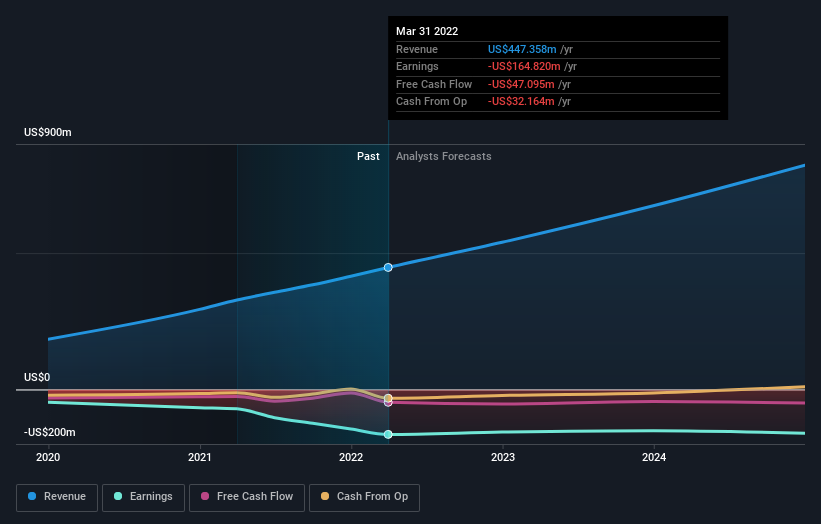US$34.00: That's What Analysts Think Coursera, Inc. (NYSE:COUR) Is Worth After Its Latest Results
Coursera, Inc. (NYSE:COUR) just released its latest first-quarter results and things are looking bullish. It looks like a positive result overall, with revenues of US$120m beating forecasts by 3.2%. Statutory losses of US$0.27 per share were 3.2% smaller than the analysts expected, likely helped along by the higher revenues. Following the result, the analysts have updated their earnings model, and it would be good to know whether they think there's been a strong change in the company's prospects, or if it's business as usual. We've gathered the most recent statutory forecasts to see whether the analysts have changed their earnings models, following these results.
Check out our latest analysis for Coursera
After the latest results, the 16 analysts covering Coursera are now predicting revenues of US$539.7m in 2022. If met, this would reflect a sizeable 21% improvement in sales compared to the last 12 months. Losses are forecast to narrow 4.2% to US$1.12 per share. Before this earnings announcement, the analysts had been modelling revenues of US$538.4m and losses of US$1.04 per share in 2022. So it's pretty clear consensus is mixed on Coursera after the new consensus numbers; while the analysts held their revenue numbers steady, they also administered a modest increase to per-share loss expectations.
With the increase in forecast losses for next year, it's perhaps no surprise to see that the average price target dipped 7.9% to US$34.00, with the analysts signalling that growing losses would be a definite concern. There's another way to think about price targets though, and that's to look at the range of price targets put forward by analysts, because a wide range of estimates could suggest a diverse view on possible outcomes for the business. The most optimistic Coursera analyst has a price target of US$45.00 per share, while the most pessimistic values it at US$26.00. This shows there is still a bit of diversity in estimates, but analysts don't appear to be totally split on the stock as though it might be a success or failure situation.
These estimates are interesting, but it can be useful to paint some more broad strokes when seeing how forecasts compare, both to the Coursera's past performance and to peers in the same industry. We would highlight that Coursera's revenue growth is expected to slow, with the forecast 28% annualised growth rate until the end of 2022 being well below the historical 36% growth over the last year. Juxtapose this against the other companies in the industry with analyst coverage, which are forecast to grow their revenues (in aggregate) 6.8% per year. So it's pretty clear that, while Coursera's revenue growth is expected to slow, it's still expected to grow faster than the industry itself.
The Bottom Line
The most important thing to take away is that the analysts increased their loss per share estimates for next year. Happily, there were no major changes to revenue forecasts, with the business still expected to grow faster than the wider industry. Furthermore, the analysts also cut their price targets, suggesting that the latest news has led to greater pessimism about the intrinsic value of the business.
Following on from that line of thought, we think that the long-term prospects of the business are much more relevant than next year's earnings. We have forecasts for Coursera going out to 2024, and you can see them free on our platform here.
That said, it's still necessary to consider the ever-present spectre of investment risk. We've identified 4 warning signs with Coursera (at least 1 which doesn't sit too well with us) , and understanding these should be part of your investment process.
Have feedback on this article? Concerned about the content? Get in touch with us directly. Alternatively, email editorial-team (at) simplywallst.com.
This article by Simply Wall St is general in nature. We provide commentary based on historical data and analyst forecasts only using an unbiased methodology and our articles are not intended to be financial advice. It does not constitute a recommendation to buy or sell any stock, and does not take account of your objectives, or your financial situation. We aim to bring you long-term focused analysis driven by fundamental data. Note that our analysis may not factor in the latest price-sensitive company announcements or qualitative material. Simply Wall St has no position in any stocks mentioned.

 Yahoo News
Yahoo News 
